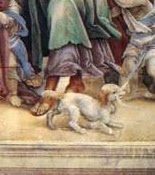John means, "grace of God" or "to whom a gift from God is given." It is said that John was given four gifts: 1. He was the most beloved apostle as shown by his presence at the Transfiguration and his resting on Christ at the Last Supper; 2. He was chaste as he was chosen as a disciple; 3. He could reveal religious mysteries as he wrote the fourth gospel, the Book of Revelation, and three Epistles making him the patron saint of theologians; 4. His chastity is again shown as he was chosen to care for the Virgin Mary when Christ was dying on the cross. Saint John became virginum custos, special protector of virgins and widows. The frescoes on the left wall of the Strozzi Chapel depict two scenes, the Ressurection of Drusiana and Saint John in Oil.
In the lower fresco, the Ressurection of Drusiana, Filippino Lippi shows Saint John the Evangelist's miracle of raising the dead. Saint John the Evangelist, who had been banished, returns to Ephesus where he was honored by the faithful. He comes across the funeral of a friend, Drusiana, and her family tells him of her devotion to Saint John and her wish to have seen him before she died. Saint John stopped the procession and ordered Drusiana to rise up and go home to prepare food. Drusiana did as Saint John stated.
We see the city gate far in the background. In the center is John and Drusiana. Woman and children are on the right and the funeral procession leads us off to the left. There is a limited sense of perspective of space. The funeral bier is parallel to the picture plane. The figures create a "frieze-like band" and are on a "illusionistically-treated procenium." (Sale) Several individual structures divide the piece. Filippino Lippi draws our attention to the main protagonists, Saint John and Drusiana, and then to the funeral procession as a whole.
Sales, in his dissertation Lippi's Strozzi Chapel, states that the scene appears more pagan than Christian. An example of this is the staff on which the banner is attached. There are sprigs of cypress on top and also in the hair of the woman carrying the banner. Sale states that Festus, repeating Servius on Aeneid, reads:
Cypresses were therefore placed at the houses of
the dead, because a tree of this type, once cut
off, will not sprout again, just as from the
dead there is nothing further to be hoped; for
this reason it was judged to be under the patronage of Pluto.
Also, we notice that the dramatically-cloaked cleric is holding an urn, possibly for Drusiana's ashes after cremation.
The zoomorphic iconography relates to time (past, present, and future) as does the Strozzi circle (no beginning or end) with wings, showing flight and speed.
This lower scene on the left wall of Strozzi Chapel implies the promise of resurrection to our chapel patron, Filippo Strozzi, who is buried within. Like Saint Phillip (battling Mars) across on the lower right wall, Saint John confronts these pagan rituals. By bringing Drusiana back from the dead, Saint John saves her from the pagan life and shows the powerful effects of Christianity.
The lunette above depicts the martyrdom of Saint John at the Latin Gate in Rome. Saint John had gone to Asia Minor to preach at Ephesus. He was taken prisoner by the proconsul and refused to participate in sacrifices to the local gods. The emperor, Domitian, sent him to Rome and had him sacrificed in a cauldron of boiling oil. Saint John felt no pain and received no injuries. He was exiled to the island of Patmos where he composed the Book of Revelation.
We see Saint John as he prays in the cauldron. The emperor orders that more fire be generated below. A figure stands to the left with pieces of armor strewn below him. There is an imperial advisor with a turban. Next, we see the emperor, Domitian, rising from his throne. He is classicized with a laurel wreath on his head.
To the right of Saint John, we see the god Mercury with a caduceus in one hand and a sphere in the other. This tells us that the scene we are looking at is judicially legal yet morally unjust, reinforcing the emptiness of power when in the face of Christianity. There are more figures to the right and an elaborately-dressed soldier draws us back into the piece.
Was the choice of these two scenes of San Giovanni Evagelista intended to balance those of the right wall (Saint Phillip's crucifixion above and his exorcism of the dragon from the altar of Mars below)? Although there is much more iconography for Saint John, we must consider that Filippino Lippi chose these two scenes to balance the wall fresco cycles of the Strozzi Chapel.








Great detail! "Rise up and go home to prepare food!"
ReplyDelete